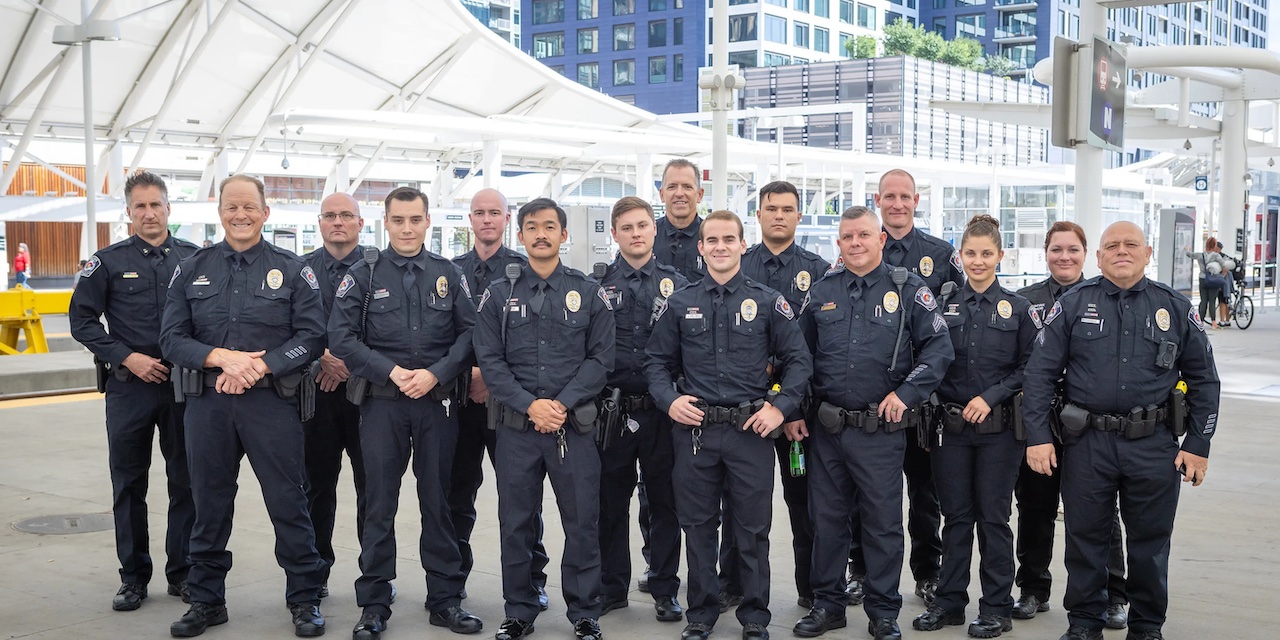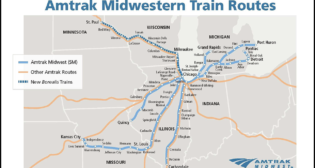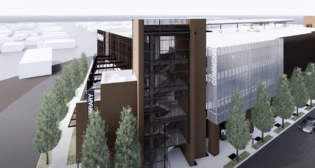
Transit Briefs: Metra, Denver RTD, Amtrak OIG
Written by Carolina Worrell, Senior Editor
Beginning May 5, RTD-PD will move to a 24/7 staffing model. (Denver RTD photo)
Metra schedules 47 safety blitzes in 2024. Also, Denver Regional Transportation District’s (RTD) Transit Police will implement 24/7 patrols beginning May 5; and the Amtrak Office of Inspector General (OIG) identifies opportunities for Amtrak to better use its customer service data to improve the customer experience.
Metra
Metra announced April 22 that it will conduct Operation Lifesaver (OLI) safety blitzes at 47 train stations across the six-county region in 2024 as part of its “ongoing efforts to raise awareness about the importance of safe behavior around its trains and tracks.”
During a safety blitz, Metra employees will visit one of the railroad’s 242 stations during the morning rush hour, distributing educational materials about train and grade crossing safety, answering questions, and listening to riders’ safety concerns. A short video about grade crossing safety is also available for customers to view while they wait for their trains. Local police, fire and other public officials are also invited to participate.
“Safety is always Metra’s highest priority,” said Metra CEO/Executive Director Jim Derwinski. “These safety blitzes allow us to reach our customers directly to ensure that they understand the need to stay vigilant about safety anytime they’re around the railroad.”
Illinois has the nation’s second-largest rail system with more than 7,300 miles of railroad track and 10,264 public rail crossings. In 2023, Illinois ranked sixth in the nation in train vs. vehicle collisions at highway rail crossings and fifth in the nation in trespassing fatalities. Preliminary statistics compiled by the Federal Railroad Administration (FRA) show that in 2023, 18 people died and 21 people were injured in grade crossing incidents in Illinois and another 35 people were killed and 20 people were injured trespassing along railroad right-of-way.
To help promote rail safety awareness and eliminate preventable injuries and deaths, Metra develops an annual schedule of safety blitzes throughout the Chicago metropolitan area. The complete 2024 safety blitz schedule can be found here.
The safety blitz program’s primary purpose, Metra says, is educational. Metra Police will also conduct additional enforcement blitzes at locations throughout the region, where citations and warnings will be issued to pedestrians and drivers who ignore gates and warning devices.
Metra also promotes safety through its annual Safety Competition for the region’s students and conducts hundreds of free OLI presentations annually to schools, community groups, school bus drivers, professional truck drivers, emergency responders and other organizations throughout the region.
More information is available here.
Denver RTD
Beginning May 5, the Denver RTD Police Department (RTD-PD) is moving to a 24/7 staffing model, the agency announced April 22. Overnight coverage, the agency says, “will enhance the personal safety and security of RTD’s frontline employees and customers, including those who use the agency’s transit services outside of regular business hours.”
“The introduction of an overnight team has been a priority for RTD-PD, and it was always contingent upon our hiring success,” said Chief of Police and Emergency Management Dr. Joel Fitzgerald Sr. “We needed enough staff to begin to provide the high-performance service our stakeholders expect. As we continue to grow, you’ll see us even more.”
RTD-PD currently has 61 Colorado Peace Officers Standards and Training (POST)-certified officers. An additional 19 recruits are in the police academy and will graduate in May. Another 26 recruits are projected to attend the academy in July. The agency says it plans to grow to a minimum of 119 officers by the end of the year as part of its efforts to create a welcoming transit environment across the district’s entire service area. RTD provides bus, rail and paratransit services in a 2,342-square-mile area that spans all or part of eight counties and 40 municipalities. In 2023, RTD had approximately 65 million customer boardings.
“Being able to respond to more calls for service and process more of our own arrests makes us a force multiplier for other law enforcement agencies,” Fitzgerald said. “This means that RTD will always be a priority and our department is viewed as a better partner. All members of the RTD-PD team will do everything in our power to ensure that customers and employees are safe on the RTD system.”
The overnight team, RTD says, will focus on areas in need of greater safety efforts for bus and rail operators, such as when employees begin their morning shifts at Denver Union Station. As RTD-PD continues to grow, the additional officers will help the department proactively address other problems on bus and rail vehicles, as well as situations at stops and stations around the district.
“We know that problems can occur at any time, so this is another step toward meeting the goal of a creating a welcoming transit environment 24/7, 365 days a year,” Deputy Chief Glyn Horn said, adding that an overnight presence will enhance the safety of RTD’s employees who work late and overnight shifts. “We will do everything possible to ensure our employees are safe in the work environment. We are one RTD.”
In August 2022, the agency had 19 sworn officers and relied heavily on contracted security. Since that time, RTD has grown and focused its efforts and resources on building its own force. The move, the agency says, not only supports the personal safety, security and well-being of RTD’s employees and customers, but it also allows for evidence-based policing and the strategic deployment of officers to problematic areas.
RTD says it also plans to add community outreach staff, staffing six mental health clinicians and five homeless outreach coordinators by year-end to work alongside Transit Police officers. The outreach program, RTD says, “has fostered agency relationships to increase customer access to resources in the RTD service area while helping to keep transit services running smoothly.”
Amtrak OIG
Amtrak can better use the data it already collects to improve the customer experience, according to a report from Amtrak OIG released on April 22.
According to the report (download below), OIG identified three opportunities, mostly related to communications, for Amtrak to use its customer feedback data “to bolster its overall service improvement efforts.”
First, OIG found that customers on delayed trains received communications about those delays at widely varying times or sometimes not at all. Sometimes, notifications about delays on long-distance trains came 12, 16, and 24 hours after the delays began, the report said.
Amtrak could not easily determine whether it sent communications about specific en route delays, nor when it sent them, however, because the communications were not stored in a centralized repository and not readily accessible. During the audit, Amtrak’s Digital Technology department consolidated all of the communications Amtrak sends to one repository, but the data are still not easy to access or filter, according to Amtrak officials, so they are working to create dashboards to provide easier access to this information.
The second opportunity OIG identified was that Amtrak could better use its existing data to measure and improve the performance of its call centers. Amtrak’s primary measure for call center performance is average speed to answer, which it improved to five minutes and 30 seconds in fiscal year 2023 but is still above its goal of two minutes and 30 seconds.
At the same time, OIG found that Amtrak “does not measure or have goals related to other commonly used metrics in the call center industry.” This includes abandoned calls (about 25% of Amtrak’s calls were abandoned in FY 2022 and 15% were abandoned in FY 2023). For abandoned calls, OIG research suggests that call center industry averages are approximately 5%, and acceptable upper limits are from 9-10%. In addition, OIG says Amtrak does not have goals to address the number of calls on hold for 30 minutes or longer. As a result, “Amtrak is missing an opportunity to fully evaluate its call center performance and determine how much to invest to improve these aspects of the customer experience,” the report said.
The third opportunity identified by OIG was that Amtrak could improve its internal use of customer feedback. OIG found that a recently developed feature used to track actions in response to customer feedback faced challenges “because Marketing department officials did not include Operations personnel when developing this feature.”
OIG recommended a series of actions to improve Amtrak’s use of customer feedback data, including establishing thresholds and goals to measure its performance in communicating with customers, measuring other aspects of call center performance, and conducting a review of its recent changes to the call center case management system. The company agreed with the recommendations and plans to address them.



